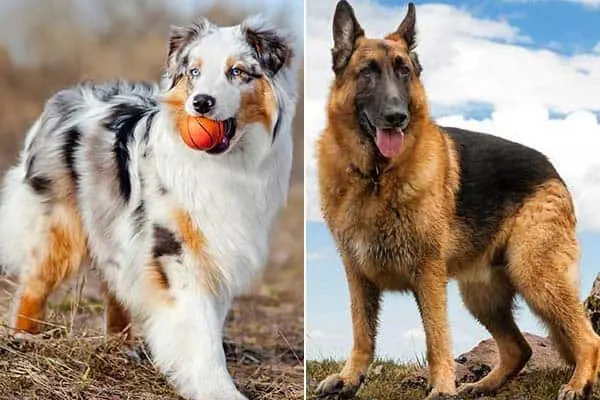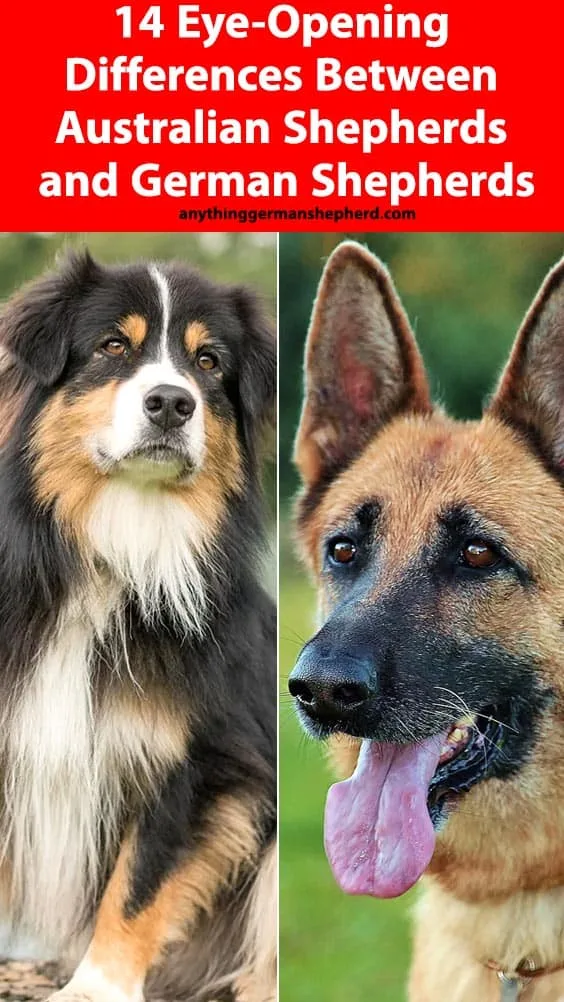German Shepherd vs Australian Shepherd: 14 Eye-Opening Differences
Although their names are similar, Australian Shepherds (or Aussies) are very different from German Shepherd dogs (usually known as GSDs or Alsatians.)
Both dogs are highly intelligent, people-loving, and were bred to help control livestock. They also share misleading names.
However, these dog breeds differ in many ways which makes them easy to tell apart.
They differ in size, color, ear shape, and whether or not they have tails.
They also differ in popularity, health, life expectancy, and country of origin.
To help prospective dog owners, we have compiled a list of the fourteen main differences between Australian Shepherds and German Shepherds.
Let’s dive in!

One: Differences in Size
Australian Shepherds are noticeably smaller than German shepherds. Aussies measure from eighteen inches high at the shoulder for a small female to 23 inches high for a large male.
In contrast, German Shepherds measure from 22 to 26 inches high. Like the Aussies and other dog breeds, females are usually (but not always) smaller than males.
Dogs are measured from their forepaws to their withers or the highest point of their shoulders.
Two: Differences in Weight
Aussies are not only smaller but are built lighter than robust German Shepherds. Aussies’ average weights range from 40 to 65 pounds.
In contrast, GSDs weigh from 50 to 90 pounds. And no, GSDs are not “bigger boned”.
Because Aussies are so much lighter than GSDs, they are not used often by the police. Aussies are not large enough to take down an aggressive criminal.
Aussies can work as drug dogs, bomb-sniffing dogs, and can sniff out traces of corpses at crime scenes or after wildfires.
Three: Differences in Ear Shape
All puppies are born with floppy ears. As the puppies get older, some will stick up and some will not.
In the Aussie, the ears are held mid-way between pointed ears like a German Shepherd or the very floppy ears of a bloodhound.
There are some rare Aussies that have pointed ears and some GSDs with floppy ears. They are still purebreds, just with different-shaped ears.
These ear shapes are frowned upon and are not allowed in the show ring.
Four: Differences in the Tails
Both dog breeds are born with tails. However, it’s considered “proper” to dock (partially remove) or bob (completely remove) the tails of Aussie puppies.
According to AKC rules, no Aussie can be shown without a docked or bobbed tail.
Attitudes are changing. In many countries like the United Kingdom and (ironically) Australia, it is now illegal to dock or bob a tail for purely cosmetic purposes.
America and Canada are countries where docking is bobbing and is still done routinely and without restrictions.

Five: Differences in Country of Origin
Both dog breeds are the same in that they are NOT named for their country of origin. German Shepherds originated in the Alsatian area of France.
This is why most countries in the world prefer to call GSDs Alsatians.
And what about the Australian Shepherd?
Guess where they are from… not Australia surprisingly… but California!
They derive from breeds in Europe and Australia, but the breed as we know it today originated on ranches and farms in California.
Six: Differences in Popularity
There are far more German Shepherds in the world than Australian Shepherds. In America for example, according to the AKC, the GSD is the second most popular dog breed while the Aussie ranks seventeenth.
However, the Australian Shepherd is a younger breed. Considering that the first Aussies appeared in the 1940s, this breed is doing remarkably well.
It could happen that someday soon the Aussie will overtake the GSD in popularity.
Seven: Differences in Life Expectancy
The Aussie has another edge over the GSD in that they tend to live longer. On average, Australian Shepherds live to be from thirteen to fifteen years old.
In contrast, the German shepherd rarely lives beyond thirteen years old.
Why is this?
It is known that larger dogs live shorter lives than smaller ones because they age faster. Just why larger dogs age faster is unknown.
Eight: Differences in Coat Color
GSDs are wonderful, intelligent, and versatile dogs, but they do have a limited color palette. Mostly they are black and tan.
They also come in black, black and cream, black and silver, white (a controversial color), liver (a dark brown), liver and tan, sable, grey and blue.
In contrast, Aussies come in many more colors. Often these coats show mixes of two or more colors.
Official colors include all black, all red, all liver, merle (a mix of colors), blue merle, red merle, black and white, red and white, black and tan, blue merle and tan, and tricolor (or three-colored dogs.)

Nine: Differences in Coat Lengths
Both Aussies and GSDs have double coats or coats with two layers. The inner layer is soft and thick while the outer layer is harsher to ward off bad weather.
The moderate is thought to be the “original” length while the longer is for show dogs, but nothing can be proved.
However, Australian Shepherds come in just two coat lengths, moderate and long. GSD coats come in three lengths, short, medium (or moderate), and long.
The most common type is medium length.
Ten: Differences in Contracting Pannus
German Shepherds have been victims of their own success. Because they are so in demand, many unscrupulous breeders over the decades inbred their dogs.
This produced many health problems that are not apparent in most other dog breeds.
One incurable eye condition is called German Shepherd keratitis or pannus. Almost all sufferers are GSDs, although it very rarely appears in Belgian Tervurens and border collies.
The condition causes changes in the cornea and inner eyelid to cause blindness, notes VCA Animal Hospitals.
Eleven: Differences in Susceptibility to Pancreatic Enzyme Insufficiency
Just looking at the name, you can tell that pancreatic enzyme insufficiency is a big problem with the pancreas.
According to the Mid-Atlantic German Shepherd Rescue, this condition causes the dog to no longer be able to digest most nutrients from food.
Although not curable, this condition can be treated. Many owners, unfortunately, choose to put their GSDs down because they cannot afford the treatments.
Hopefully, Aussies will never be so inbred as to develop life-threatening medical problems like pancreatic enzyme insufficiency.
Twelve: Differences in Developing Panosteitis
Also called wandering bone or pano, panosteitis is an inflammation in the growth of the long parts of the leg bones.
All dog breeds can get this disease, but larger breeds like the German Shepherd are far more likely to get it than medium-sized breeds like the Australian Shepherd.
This is a very painful condition, but it is treatable. Since this runs in families, any dog developing pano should never be bred, warns the Australian Shepherd Health & Genetics Institute.
Symptoms of lameness and appetite loss most commonly appear when a puppy is five to eighteen months old.
Thirteen: Differences in Getting Degenerative Myelopathy
Oh, yes, the GSD hit the genetic jackpot if the jackpot consists of medical problems rarely if ever, found in other dog breeds, including the Aussie.
Degenerative myelopathy or DM is almost exclusively found in GSDs. It is incurable and often fatal.
This is a disease of the spine. The GSD, usually about seven years old, starts walking oddly and then gradually becomes paralyzed in the hind legs.
There are very few treatment options available.
Fourteen: Differences in Use as Rescue Dogs
The high intelligence and willingness to please their people make both Aussies and GSDs ideal for search and rescue work.
A German Shepherd named Appollo even won high praise and awards for his work at Ground Zero after the 9/11 terrorist attacks.
However, for avalanche rescue, Aussies are preferred because they are easier to pick up and carry.
Many avalanche rescue humans need to carry their dogs on their backs while they ski up and down mountains to the avalanche site.

GSD vs Australian Shepherd: No Good Dog Is From A Bad Breed
Although we’ve looked at fourteen big differences between the German Shepherd and the Australian Shepherd, they are similar in many respects.
Both are popular breeds for good reason. They learn quickly, they love people and they love to work or play.
Here we compared the differences between the average Aussie and the average GSD.
Please keep in mind that each dog will differ from others, including members of his or her own litter, so it is possible to find Aussies or GSDs that are far from average.
It may seem that GSDs got the short end of the stick genetically, but hopefully, some of their health issues can be bred out of them.
Both dog breeds are good dog breeds in that they are loving and make wonderful pets.
Here is an article about the mix of both breeds together: “How To Make a Better Life With a German Shepherd Australian Shepherd mix”






























